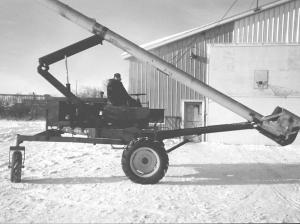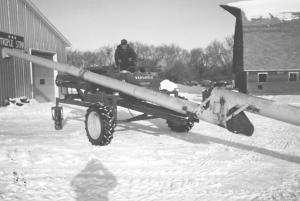2001 - Volume #25, Issue #5, Page #28
[ Sample Stories From This Issue | List of All Stories In This Issue | Print this story
| Read this issue]
Self-Propelled Auger Is Maneuverable And Fast
 |
 |
"What we needed was an auger that we could move around easily, but one that had the capacity to move grain quickly," he says. "We found that 8-in. augers didn't have the capacity we wanted, and 10-in. augers were just too big to move easily."
With a little ingenuity, Toews combined a big Bergen auger with an old Versatile 400 swather to make a self-propelled auger that's highly maneuverable and moves grain quickly. "We can load 75 to 100 bushels a minute with this auger," he says.
The Bergen auger is 50 ft. long and 10 3/4 in. in diameter.
He bought the Versatile swather specifically for this purpose. "It's a small machine with a single rear caster wheel and hydrostatic drive which makes it very maneuverable," he says. "And its 6-cylinder engine gives it plenty of power."
Toews paid about $1,000 Canadian for the swather which was in good working order. The only thing he found wrong with it was a cracked manifold, which was easily replaced.
His first step in the conversion was removing the old header from the swather. Then he moved the rear dolly wheel from the left side to the right side. "We made use of all the existing parts and it wasn't difficult to change it. We did add a length of 2 by 5-in. steel tubing to help support the caster wheel," he notes.
The lower end has a short lift that allows it to be raised for transport. For this, he intended to use the hydraulic cylinder from the cutting platform. "It was too small and the action was too fast on that cylinder, though, so we opted for a 2 1/2 by 24-in. cylinder instead."
He built a scissors hoist to support the top of the auger. This hoist, made of two lengths of 2by 4 steel tubing, is hinged at the top of the auger where it attaches together, and where it's mounted on the swather frame. A 3-in. hydraulic cylinder with a 36-in. stroke opens and closes the scissors hoist. "I wanted to be able to raise the top of the auger at least 25 ft. in the air. It took a little bit of trial and error to get the hoist arm lengths correct, but we ended up being able to raise the auger to a height of more than 30 ft.," he says.
The swather had two sets of hydraulics - one for the header and one for the reel. Both are controlled by foot pedals. He now uses one pedal for the upper cylinder and another for the lower one.
To power the auger, he extended the power-take-off that powered the cutter head using shafts and universal joints, so it runs parallel to the auger. He used the same pulleys and idler for the clutch that had run the cutterbar.
The auger was originally set up to be powered by a tractor pto. He removed the gearbox and, since the shaft runs parallel to the auger, added a sprocket which drives the auger via a double no. 60 roller chain.
"We had to do some experimenting with sprocket size in order to get the auger to run at the right speed," he says.
The auger also has a sweep attachment at the bottom. This he powered hydraulically with an additional hydraulic pump. "We used pulleys that were already on the engine."
Toews mounted two headlights - one on the rear, and one at the top of the auger. "It helps when we're loading trucks at night," Toews says. He reports that some members of his family now call the rebuilt swather a "swauger."
Contact: FARM SHOW Followup, Bernie Toews, 35 11 10W SE, Macgregor, Manitoba, Canada R0H 0R0 (ph/fax 204 685-2045).

Click here to download page story appeared in.

Click here to read entire issue
To read the rest of this story, download this issue below or click here to register with your account number.




